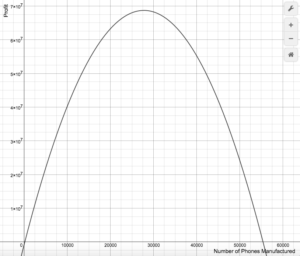Introduction to Factoring
Learning Outcomes
- Use the principle of zero products to solve equations
- Determine for what kind of equations the principle of zero products can be used
- Explain why some techniques for solving linear equations don't work for solving polynomial equations
[latex]P=-0.09x^2+5000x-750,000[/latex]
Using an online graphing calculator, we generated this graph of the profit equation.
 A manager may want to know for what amount of phones manufactured and sold will a profit be made. By substituting 100 in for x, we discovered that when 100 phones were manufactured and sold, the company did not make a profit.
Substitute x = 100
A manager may want to know for what amount of phones manufactured and sold will a profit be made. By substituting 100 in for x, we discovered that when 100 phones were manufactured and sold, the company did not make a profit.
Substitute x = 100
[latex]\begin{array}{c}P=-0.09x^2+5000x-750,000\\=-0.09\left(100\right)^2+5000\left(100\right)-750,000\\=-900+500,000-750,000\\=-250,900\end{array}[/latex]
Finding the points where profit is greater than or equal to zero will guide management decisions, and help the company plan to have enough labor and materials on hand. Knowing where profit equals zero gives the company a baseline from which to plan. On the graph, profit is zero when the parabola crosses the x-axis. In algebraic terms, this means finding where the profit equation is equal to zero:
[latex]\begin{array}{c}P=-0.09x^2+5000x-750,000\\0=-0.09x^2+5000x-750,000\\0<-0.09x^2+5000x-750,000\end{array}[/latex]
We know how to solve linear equations like this: [latex]x-4=0[/latex], and linear inequalities like this: [latex]x-4>0[/latex]. But, how do you solve a polynomial equation like this: [latex]0=-0.09x^2+5000x-750,000[/latex], or an inequality like this: [latex]0<-0.09x^2+5000x-750,000[/latex]?
In this section we will learn some very useful tools for solving certain kinds of polynomial equations, and in later math courses you will likely learn how to extend these ideas to solving polynomial inequalities. The first concept we will explore is that of the zero product property, then we will discuss how that can be used to solve polynomial equations.
The Principle of Zero Products
 Zero
ZeroPrinciple of Zero Products
The Principle of Zero Products states that if the product of two numbers is 0, then at least one of the factors is 0. If [latex]ab=0[/latex], then either [latex]a=0[/latex] or [latex]b=0[/latex], or both a and b are 0.Example
Use the principle of zero products to solve. [latex]5y=0[/latex]Answer: By the principle of zero products, when two factors are multiplied and the result is zero at least one of them is equal to zero. Therefore, either [latex]5=0[/latex], or [latex]y=0[/latex]. In this case, we know that 5 is not equal to zero, so [latex]y[/latex] must be equal to zero. We can verify this with algebra.
[latex]\begin{array}{c}5y=0\\\text{}\\\frac{5y}{5}=\frac{0}{5}\\\text{}\\y=0\end{array}[/latex]
Answer
Both by the principle of zero products, and with algebra, we have shown that [latex]y=0[/latex].Example
Use the principle of zero products to solve: [latex-display]7\left(y-2\right)=0[/latex-display]Answer: By the principle of zero products, either [latex]7 = 0[/latex], or [latex]\left(y-2\right)=0[/latex]. We know that [latex]7\neq0[/latex], so we are left with [latex]\left(y-2\right)=0[/latex]. We know how to solve this kind of equation! We can remove the parentheses because they are not needed to solve.
[latex]\begin{array}{c}y-2=0\\\,\,\,\,\,\,\,\,\,\underline{+2}\,\,\,\,\,\,\underline{+2}\\\text{}\\\,\,\,\,\,\,\,\,\,\,y=2\end{array}[/latex]
We can check this is correct by substituting 2 for y into the original equation.
[latex]\begin{array}{c}7\left(2-2\right)=0\\7\left(0\right)=0\\0=0\end{array}[/latex]
This statement is true, so we have found the correct value for y.
Answer
[latex]y=2[/latex]
[latex]\begin{array}{c}7\left(y-2\right)=0\\7y-14=0\\\,\,\,\,\,\,\,\,\,\underline{+14}\,\,\,\,\,\,\underline{+14}\\\text{}\\7y=14\\\text{}\\\frac{7y}{7}=\frac{14}{7}\\\text{}\\y=2\end{array}[/latex]
We have the same answer that we verified in the example, but we used different algebraic principles to find it.
In the next example we add another layer to the idea that we can use the principle of zero products to solve equations. We will solve an equation that contains the product of a variable and a binomial.Example
Use the principle of zero products to solve: [latex-display]t\left(5-t\right)=0[/latex-display]Answer: By the principle of zero products, either [latex]t=0[/latex] or [latex]\left(5-t\right)=0[/latex] [latex-display]\displaystyle\begin{array}{c}t=0\,\,\,\,\,\,\,\,\,\text{OR}\,\,\,\,\,\,\,\,5-t=0\\\,\,\,\,\,\,\,\,\,\,\,\,\,\,\,\,\,\,\,\,\,\,\,\,\,\,\,\,\,\,\,\,\,\,\,\,\,\,\,\,\underline{-5}\,\,\,\,\,\,\,\,\,\,\,\,\,\,\,\underline{-5}\\\,\,\,\,\,\,\,\,\,\,\,\,\,\,\,\,\,\,\,\,\,\,\,\,\,\,\,\,\,\,\,\,\,\,\,\,\,\,\,\,\,\,\,\,\,\,\,\,\,\,\,-t=-5\\\,\,\,\,\,\,\,\,\,\,\,\,\,\,\,\,\,\,\,\,\,\,\,\,\,\,\,\,\,\,\,\,\,\,\,\,\,\,\,\,\,\,\,\,\,\,\,\,\,\,\frac{-t}{-1}=\frac{-5}{-1}\\\,\,\,\,\,\,\,\,\,\,\,\,\,\,\,\,\,\,\,\,\,\,\,\,\,\,\,\,\,\,\,\,\,\,\,\,\,\,\,\,\,\,\,\,\,\,\,\,\,\,\,t=5\\\text{}\\t=0\,\,\,\,\,\,\,\,\,\,\,\,\text{OR}\,\,\,\,\,\,\,\,\,\,\,\,\,\,\,t=5\end{array}[/latex-display] Wow, two answers! Let's check that they are both correct. Substitute [latex]t=0[/latex]
[latex]\begin{array}{c}t\left(5-t\right)=0\\0\left(5-0\right)=0\\\,\,\,\,\,\,\,\,\,\,0\left(5\right)=0\\\,\,\,\,\,\,\,\,\,\,\,\,\,\,\,\,\,\,\,\,0=0\end{array}[/latex]
[latex-display]t=0[/latex] checks, now let's check [latex]t=5[/latex-display] Substitute [latex]t=5[/latex][latex]\begin{array}{c}5\left(5-5\right)=0\\\,\,\,\,\,\,\,\,\,\,\,5\left(0\right)=0\\\,\,\,\,\,\,\,\,\,\,\,\,\,\,\,\,\,\,\,\,0=0\end{array}[/latex]
[latex]t=5[/latex] also checks. There are two answers to this equation.Answer
[latex-display]t=0\text{ OR }t=5[/latex-display][latex]\begin{array}{c}t\left(5-t\right)=0\\\text{}\\5t-t^2=0\\\underline{-5t}\,\,\,\,\,\,\,\,\,\,\underline{-5t}\\t^2=-5t\\\text{}\\t\cdot{t}=-5t\\\text{}\\\frac{t\cdot{t}}{t}=\frac{-5t}{t}\\\text{}\\t=-5\end{array}[/latex]
Wait, in the example, our solution was [latex]t=0\text{ OR }t=5[/latex]. Let's check this new answer to see if it is correct. Substitute [latex]t=-5[/latex][latex]\begin{array}{c}-5\left(5-\left(-5\right)\right)=0\\-5\left(5+5\right)=0\\-5\left(10\right)=0\\-50\neq{0}\end{array}[/latex]
This isn't even the right answer!
When we are solving polynomial equations, we need to use some different methods than we used to solve linear equations to make sure we get all of the correct answers. The principle of zero products is one tool that allows us to do this.
 Caution! It is important to remember that the principle of zero products only works when we have an equation with zero on one side, and only a product on the other side. The table below gives examples of equations for which you can and cannot apply the principle of zero products.
Caution! It is important to remember that the principle of zero products only works when we have an equation with zero on one side, and only a product on the other side. The table below gives examples of equations for which you can and cannot apply the principle of zero products.
| YES Zero Products Works to Solve | NO Zero Products Does Not Work to Solve | WHY NOT? |
| [latex]\frac{1}{2}\left(x-2\right)=0[/latex] | [latex]\frac{1}{2}\left(x-2\right)=28[/latex] | There is a product on the left, but it is not equal to zero. |
| [latex]s\left(9+s\right)=0[/latex] | [latex]s^2+9s=0[/latex] | There is a sum equal to zero but no product equal to zero. |
Example
Use the principle of zero products to solve: [latex-display]\left(s+1\right)\left(s-5\right)=0[/latex-display]Answer: Set both products equal to zero, then solve the linear equations. [latex-display]\begin{array}{c}\left(s+1\right)=0\\s+1=0\\\underline{-1}\,\,\,\,\,\,\,\underline{-1}\\s=-1\end{array}[/latex-display] [latex-display]\begin{array}{c}\left(s-5\right)=0\\s-5=0\\\,\,\,\,\,\,\,\,\,\,\,\underline{+5}\,\,\,\,\,\underline{+5}\\\,\,\,\,\,\,\,\,\,s=5\end{array}[/latex-display]
Answer
[latex-display]s=-1\text{ OR }s=5[/latex-display]| [latex]s[/latex] | [latex]+1[/latex] | |
| [latex]s[/latex] | [latex]s^2[/latex] | [latex]s[/latex] |
| [latex]-5[/latex] | [latex]-5s[/latex] | [latex]-5[/latex] |
Licenses & Attributions
CC licensed content, Original
- Revision and Adaptation. Provided by: Lumen Learning License: CC BY: Attribution.
- Screenshot: Zero. Provided by: Lumen Learning License: CC BY: Attribution.
- Screenshot: Caution. Provided by: Lumen Learning License: CC BY: Attribution.
CC licensed content, Shared previously
- Ex: Solve an Equation in Factored Form. Authored by: James Sousa (Mathispower4u.com) . License: CC BY: Attribution.
- Unit 12: Factoring, from Developmental Math: An Open Program. Provided by: Monterey Institute of Technology and Education Located at: https://www.nroc.org/. License: CC BY: Attribution.
